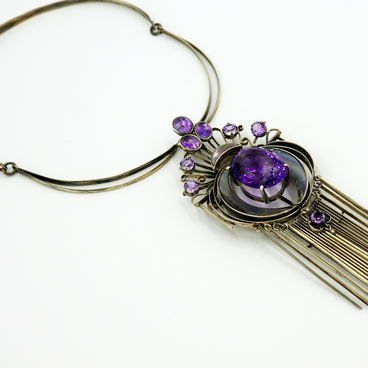A garniture is a set of decorative items of jewelry made in the same style. The set “Still Waters” which was created in 1993 by Yekaterinburg jeweler Mikhail Lesik includes earrings and a necklace of moss agate, garnet and uvarovite in a cast melchior frame.
The pectoral jewelry from this set has an asymmetrical composition, reminiscent of a lush garland. The flowers in it are made of green uvarovite and dark red garnets. In the center of the composition is a large irregular shaped plate of moss agate. In its lower part another uvarovite flower is mounted. Long melchior “tendrils” are attached to the flower’s core made of faceted oval garnet. One of the tendrils ends in a miniature garnet drop.
For the earrings, the craftsman chose asymmetrical but similar agate plates in the form of a triangle with rounded corners. Under them are pendants which look like a metal bow with an uvarovite plate.
The creator of the set, Mikhail Lesik, was born in 1938 in the village of Smirnov in northern Kazakhstan. In 1958, he graduated from the Sverdlovsk Art and Industrial School No. 42. After that, he worked at the “Russkiye Samotsvety” (Russian Gemstones) factory for 16 years, and then, in 1974, he joined the Sverdlovsk Jewelry Factory to work as an artist-couturier.
Lesik exhibited his first jewelry piece, the “Ivushka” necklace, at the Sverdlovsk Regional Art Show in 1974. Later his works were presented in Ufa, Moscow, Prague and other Russian and foreign cities.
Mikhail Lesik’s jewelry mainly look like floral compositions: he used stones and metal to make images of flowers, leaves and stems. Such motifs were most often found in the works of this artist. However, he created almost all of his works not for everyday wear, but for museum exhibitions.
The artist regarded ornamental stone as a flexible material from which any image and shape can be created. He combined in his jewelry different colors and textures, united faceted stones and naturally-shaped minerals. Lesik preferred to make frames from nickel or melchior: in his opinion, these metals emphasized the beauty of the main material and did not distract the viewer from it.
The pectoral jewelry from this set has an asymmetrical composition, reminiscent of a lush garland. The flowers in it are made of green uvarovite and dark red garnets. In the center of the composition is a large irregular shaped plate of moss agate. In its lower part another uvarovite flower is mounted. Long melchior “tendrils” are attached to the flower’s core made of faceted oval garnet. One of the tendrils ends in a miniature garnet drop.
For the earrings, the craftsman chose asymmetrical but similar agate plates in the form of a triangle with rounded corners. Under them are pendants which look like a metal bow with an uvarovite plate.
The creator of the set, Mikhail Lesik, was born in 1938 in the village of Smirnov in northern Kazakhstan. In 1958, he graduated from the Sverdlovsk Art and Industrial School No. 42. After that, he worked at the “Russkiye Samotsvety” (Russian Gemstones) factory for 16 years, and then, in 1974, he joined the Sverdlovsk Jewelry Factory to work as an artist-couturier.
Lesik exhibited his first jewelry piece, the “Ivushka” necklace, at the Sverdlovsk Regional Art Show in 1974. Later his works were presented in Ufa, Moscow, Prague and other Russian and foreign cities.
Mikhail Lesik’s jewelry mainly look like floral compositions: he used stones and metal to make images of flowers, leaves and stems. Such motifs were most often found in the works of this artist. However, he created almost all of his works not for everyday wear, but for museum exhibitions.
The artist regarded ornamental stone as a flexible material from which any image and shape can be created. He combined in his jewelry different colors and textures, united faceted stones and naturally-shaped minerals. Lesik preferred to make frames from nickel or melchior: in his opinion, these metals emphasized the beauty of the main material and did not distract the viewer from it.


